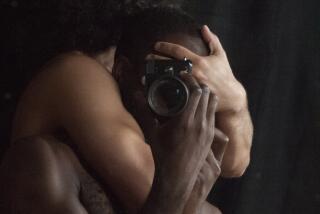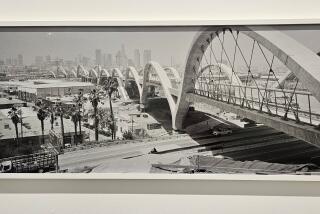Annenberg Space for Photography looks at the surreal power of Photoshop
Hands scooping up a lake, a giant brown bear cradling a baby, a man wearing a building. The wildly imaginative and surreal images in the new exhibition, “Digital Darkroom,” running at the Annenberg Space for Photography thru May, are the products of spectacular digital manipulation. This is artwork that will even amaze the Photoshop generation.
The 17 artists from the US, UK and France who created these works use all the tools that technology has to offer to orchestrate captivating results. They work like painters, but instead of using a brush they invent portraits of altered realities with digital processors, layering, meticulously stitching together multiple images and re-coloring to produce pieces that are not only technological wonders but also transcendent art.
“We wanted to showcase all this amazing talent from around the world who are really creative and inspirational,” says Russell Brown, curatorial advisor to the exhibit. Brown is Senior Creative Director at Adobe Systems and was instrumental in the introduction of Adobe Photoshop in 1990.
“When photoshop first came out it wasn’t really respected, but I think an exhibit like this shows how it’s really become a unique art form. You can’t help but get excited when you look at this work. It goes way beyond technique,” he says.
French artist Jean-Francois Rauzier drops hundreds or even thousands of photographs into a single image, each with incredible resolution and complexity. His portrait of “Versailles,” which took him two months to composite and is featured in the exhibit, could have you marveling for hours at its intricacy.
“Photoshop was the tool I was waiting for 30 years,” says Rauzier, visiting from France for the opening of the exhibit. “I think we all have different ways of working but what we have in common is that we are all dreamers.”
“I wanted to create worlds I would like to live in,” says Agoura Hills-based Brooke Shaden, who at 24 is the youngest artist to be featured. Her exquisite self portraits shot in remote Californian landscapes are dreamlike and gothic. “I’ve always been inspired by paintings. I like to describe it as dark art with a beautiful twist.”
Martine Roch’s whimsical portraits of animals heads pasted on vintage sepia portraits became an internet sensation. While recovering from breast cancer she decided to spend her time on the computer learning Photoshop. “I love animals and I loved antique photos so I looked at my dog and thought, ‘Why don’t I dress you as a lady?’ and that’s how it began,” says the gently spoken Roch, visiting from her home in Burgundy, France for the exhibit. “This is the first time my work has been displayed in Los Angeles so it’s a thrill to be included.”
But “Digital Darkroom” is not just about showcasing the new; it also celebrates one of the masters of the genre, Jerry Uelsmann, who still creates his astounding black and white portraits in the traditional dark room.
“My work is done B.C, that’s before computers,” laughs the septuagenarian artist, who began his photographic experiments back in the 1950’s, using up to seven enlargers to create the final result. “People think my work is all digital and then see I did it in 1969.
“When I saw the work of the Surrealists or even Medieval art, I was inspired. I couldn’t draw or paint so the darkroom was my vehicle,” he says. “I don’t know if I was ahead of my time, but I am so pleased that there is now recognition that this is a viable art form. We all start with something blank, whether it’s a canvas, a piece of paper or a computer screen, and then we create something new on it.”
While 80 images are on display on the walls, hundreds of additional images are shown in the Annenberg’s state of the art Digital Gallery, which houses two 14’ by 7’ high-resolution screens. There is also a 20 minute short film that shows behind-the-scenes footage and interviews with the artists talking about how their work is created.
The exhibition also includes a 3D film shot at very high resolution and shown in a special screening room which features the work of 3D artists and interviews with experts and historians.
“It’s the broadest collection we have had to date,” says Leonard Aube, Executive Director of the Annenberg Foundation. “What’s great is that this is not just for enthusiasts of the technical aspects. We really designed this to be a family friendly show. Kids are growing up with this technology, so it’s familiar to them. This exhibit is bound to inspire them.”
More to Read
The biggest entertainment stories
Get our big stories about Hollywood, film, television, music, arts, culture and more right in your inbox as soon as they publish.
You may occasionally receive promotional content from the Los Angeles Times.










